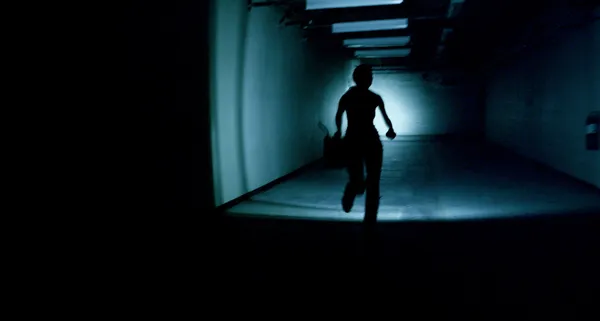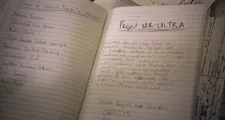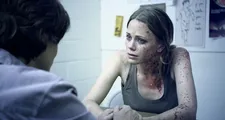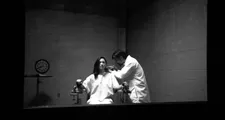 |
| You can run... |
These days, the horror genre is so prolific and so full of eager amateurs that it’s rare to see anything genuinely original. Banshee Chapter feels like a throwback to the more adventurous filmmaking of the Seventies, even before one considers its ambiguity and its psychedelic theses. It was a pleasure to catch up with director Blair Erickson and ask him how his extraordinary first feature came to be.
“I think I started just with the drug theme itself,” he said, musing on the film’s many different aspects. “I had the idea of the drug connecting to other dimensions, and that led to reading about MK Ultra and the things that they were doing to people, and thinking, what might they have unlocked? And then metaphorically, it’s about what the government is doing to all of us.”
There is also a good bit of HP Lovecraft influence in there, even before one character directly namechecks him, I suggest.
 |
| Notes on a scandal. |
“I’m a huge fan of Lovecraft,” acknowledges Blair. “I got super into that mythology and then I realised that what I was writing was in some ways a modern version of [his short story] From Beyond.”
The other prominent element in the story is radio, with mysterious signals intriguing Katia Winter’s young journalist, Anne, as she searches for a missing friend.
“When I started researching for this, strange phenomena and stuff like that just started popping up,” he says. “The number station thing [stations which consist of nothing but a series of numbers being read out] fascinated me. It’s so unusual and so eerie. I just thought, if something like this happened, it’s just the kind of thing they would communicate through, this creeping mechanical talking voice.”
It’s refreshing, I venture, to see a film with an older character alongside the younger one. How did that come about?
“It’s more interesting that way,” he says. “I’m just not interested in the usual teen slasher films where everyone goes to an island for a weekend rave and then suddenly it all goes wrong and they start dying. I was researching a narrative about a government project and the counterculture and that type of character would pop up every now and then” He cites Ken Keysey’s close connections to MK Ultra and pivotal role in bringing LSD to America, suggesting such an experiment might transform such a man into “something beyond what most people are.”
The different mindsets of the two central characters add complexity to the narrative, pitting Anne’s passion for finding the truth against the cynicism of ageing writer Thomas Blackburn..
 |
| "We called Ted Levine and he said ‘Yeah, sure I’ll do it!’" |
“I was interested in looking at the Baby Boomer generation and Generation X or Generation Y... When we were casting Blackburn it was down to about 20 names off actors we really liked, then we called Ted Levine and he said ‘Yeah, sure I’ll do it!’ He was really into the script. The female lead was harder to find, though. We went through hundreds of different videos of actresses but I really like Katia because of the gravity she brought to it. We could put her in a ridiculous situation and she could sell it through the intensity of her performance.”
He did come under pressure to alter the story, he acknowledges, but this might not have been a bad thing. There was an earlier, more optimistic version of the script that ended up becoming darker; he feels that it deserved to be more ominous because of its subject matter and he hopes it will prompt viewers to ask questions.
This is firstly about a wake-up call, he says. The point is not to argue about whether or not it’s true, “but to think, if the government could do that to us, what comes next? What is the NSA really doing and what is it capable of? I’ve heard from crazy right wingers and hard leftists, libertarians, all sorts of people, and nobody has a good thing to say about them spying on us.
“I really wanted a political subtext for this film. I think that’s there in all the best horror, like Night Of The Living Dead is about civil rights and Day Of The Dead is about consumerism... this film is about how the government does terrible things.” Shooting took place in the desert, out near Alberquerque in New Mexico. “It was a great shoot. We only had 28 days to shoot in and we were using abandoned government facilities and bunkers in the desert and there were rattlesnakes as well. Those things are really aggressive! So it was very intense and it was an experience that pushed us to do better.” None of the facilities used for the shoot had actually been used for MK Ultra or similar projects, as far as Blair knows – instead they were things like nuclear testing ranges. He credits the production crew with making it look so realistic. “It felt totally natural. I wanted to give it that Cinema Verité flavour, so there are lots of little details the eye doesn’t really quite pick up. We actually turned off a lot of the set lighting because when it was low lit it felt more natural.
 |
| "I really like Katia because of the gravity she brought to it." |
“We didn’t originally plan to shoot it was found footage but then we decided that anything before the present would be found footage and then from the present we’d use a Cinema Verité style.” Once the decision was made, they were keen to make it look natural, not too nicely lit or textured, because that could create a psychological barrier by reminding viewers they were watching a film.
“Found footage added to the sense of immersion I wanted to create. When it’s properly used, you can do incredible things with it. Cloverfield is a good example. It could have been just a monster movie but the way they used that camera made it start to feel like you were on the ground and part of the story. I’m glad we decided to do things that way or we would have had a pretty movie but not a very scary one.
“It turned out to be very hard to shoot the way we wanted. The camera rig weighed about 100lbs but most cameras would not pick up all the detail that ours did. The technology of how low a light you can shoot in now is phenomenal.”
He prefers too use ambient light as much as possible, he says, noting that in a lot of horror films “There’s the brightest blue light you’ve ever seen shining down, and that’s not what night looks like. We needed naturalism. This is what real dark looks like.”
Complementing that light, and enhancing the strange atmosphere of the film, is Mark Lenover’s music. “I absolutely love his work,” says Blair. “It’s very rare to edit a whole film and then still be able to listen to the soundtrack. One song, The Girl In The Window, is compellingly otherworldly... Lots of master copies of his work were destroyed in a fire so this is stuff no-one has ever heard.”
 |
| "The government does terrible things." |
Now that Banshee Chapter is finished and making a splash on the festival circuit, Blair is preparing to shoot his next film, which will be a ghost story “exploring how tragedy affects us.” Horror is the only genre that can really have a dark, terrible ending, he says, so he wants to shoot this film in such a way that people won’t know what genre it is until the end. “It sort of crosses a different boundary of what most horror stories and love stories are able to achieve.”
As the film needs a snowy setting and we’re now coming into spring, it won’t start shooting for a while, but if Banshee Chapter is anything to go by, it’ll be worth the wait.
Banshee Chapter is out now on DVD.





















